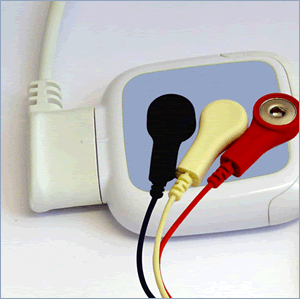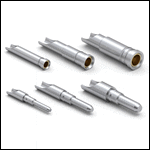Interconnect Technologies for Medical and Fitness Wearables
Building on the success of smartphones and other mobile consumer devices, medical device manufacturers continue to improve on portable and wearable monitoring devices. What does this mean for interconnect designs?

Example of a wearable waterproof ambulatory ECG medical monitoring device with three leads.
Designed to be worn on the body or attached to clothing, wearable electronic devices, also known as wearables, integrate biosensors that detect physiological markers. Healthcare and fitness wearables are proliferating as tools for monitoring exercise, nutrition, heart rate and other vital signs, blood glucose in diabetics, heart conditions, sleep apnea, and a host of other health parameters and conditions.
The Consumer Market
The global wearable technology market is expected to reach $5.8 billion in 2018, with North America leading the pack with the highest revenue (source: Global Wearable Technology Market Research Report 2018). Approximately 75% of online US consumers own a fitness technology product, with pedometers, fitness video games, and portable blood pressure monitors topping the list. Almost 10% plan to buy a smart watch within the next year (source: Consumer Electronics Association, 2014). More than 65% of mobile devices on the market are worn on the wrist, while others are designed to be worn on arms, torso, and waist (source: Transparency Market Research, 2015).
Consumers want tangible wearable device attributes such as aesthetics, ergonomics, waterproofing, and impact resistance. Devices are getting thinner, even while demand rises for faster data rates, longer battery life, and more rapid charging. Building on the success of smartphones and other mobile consumer devices, medical device manufacturers continue to improve on portable and wearable monitoring devices.
Medical and Fitness Wearables Applications
Many within the healthcare industry see wearables as a game changer for patient treatment and disease prevention. Mobile and wearable devices hold the potential to help address healthcare inefficiencies and curb ever-increasing costs. The right technologies can give healthcare providers unprecedented access to accurate real-time data needed to more cost-effectively prevent, diagnose, and treat chronic diseases and pain.
Worn during normal activities, ambulatory monitoring devices make it possible for many patients who require continuous monitoring of vital signs to leave the confines of a hospital or other clinical setting. Wearable technology can be a powerful tool to reduce unnecessary emergency room visits and reduce the rate of hospital re-admissions, while also supporting patients’ compliance with their treatment plans.
Concurrently, wearable fitness devices are gaining traction among athletes and others who want to take control of their health. Devices have evolved from basic heart rate monitoring to sophisticated multi-function monitors with integrated sensors to track heart rate, temperature, pulse, blood pressure, and other health indicators. A recent survey found that consumers are most interested in weight loss applications for tracking fitness statistics like heart rate, calories burned, and steps taken (source: CEA).
Electronic Components
Breakthroughs in sensor technologies and microminiature electronics are driving innovative new designs in wearable medical and fitness devices. In addition to boasting smaller form factors, many new medical devices incorporate capacitive and mechanical touch pads, vibrant LED displays, and other technological advances first pioneered in consumer electronics. Designing effective, efficient, and safe portable and wearable medical devices is more complex than designing for consumer devices.
Safety and Reliability Are Key
As medical devices shrink, the need for reliability and safety does not diminish. The failure of a consumer device may be bothersome, while the failure of a medical device can compromise patient safety. A myriad of inherent safety issues are associated with the design decisions made on a device intended to monitor critical vital signs or deliver lifesaving treatment.
Ambulatory medical devices demand a higher level of mechanical performance than consumer devices in order to ensure reliable operation and patient safety. Designing a high-performance cable assembly that is robust and has a long service life becomes more difficult as the physical size of materials is reduced to accommodate device portability and patient comfort. Smaller connectors and smaller gauge wires have less inherent strength than larger components. Sensors and cable assemblies used in ambulatory patient monitoring equipment are required to meet FDA and ISO safety and biocompatibility requirements. Medical device manufacturers face added layers of product development for compliance, validation, and clinical trials before releasing a product.
As wireless devices gain popularity, most medical monitoring devices continue to be wired. Wired medical monitoring devices remain the industry standard. Connectors and cable assemblies used in personal electronic devices for telecommunications or infotainment are not always appropriate for medical devices. Every design decision must take into account regulatory requirements and inherent safety issues. Reductions in cable size and bulk must be cautiously undertaken to prevent loss of mechanical or electrical performance.
Microelectronics have made possible a portable device the size of a mobile phone to perform both patient monitoring and diagnostic ECGs while a patient is fully mobile. These small devices are often equipped with thin, flexible cable assemblies for power and signal connectivity.
Flexible Circuits
Leveraging experience gained from the size reduction of consumer devices, wearable medical devices may incorporate thin, flexible circuits. For medical applications in which a rigid printed circuit board (PCB) is not appropriate, some interconnect manufacturers offer custom flexible printed circuits. Flexible printed circuits can contain up to 20 layers, offer millions of flex cycles, and be designed to handle high-speed data up to 10 Gigabits per second.
As the size and bulk of cables used in medical devices decrease, the design must be right to prevent loss of mechanical or electrical performance. The cable assembly must deliver a service life consistent with the device to which it will be attached. Advances in construction allow for thin, flexible, lightweight medical cable assemblies that can optimize performance and durability.
The flexibility of cable material is a different characteristic than the flex life of a cable assembly. When designing a cable assembly, it is important to understand the role of each characteristic and how it affects the intended use. A long flex life—high number of flex cycles before failure—is an important characteristic for cables intended to be used for an extended period of time. High flexibility is a characteristic that allows a cable to be bent to a small radius without a reduction in performance or damage to the cable. For some applications, both characteristics may be desirable or even necessary.
Flexible circuitry can provide greater design options at an economical cost. For wearable medical devices to become more common or gain greater utilization, the design of any accompanying wires, cables, and connectors can present engineering and manufacturing challenges. Because device manufacturers do not commonly have sufficient experience designing and manufacturing connectors and cable assemblies, the most economical and expeditious path may be to partner with a company that specializes in medical device electronic solutions.
 Hank Mancini is marketing manager for Affinity Medical, a subsidiary of Molex Incorporated. In his 30-year career in the medical industry, Hank has worked in almost every facet of the business, including manufacturing, new product development, sales, marketing, and strategic management.
Hank Mancini is marketing manager for Affinity Medical, a subsidiary of Molex Incorporated. In his 30-year career in the medical industry, Hank has worked in almost every facet of the business, including manufacturing, new product development, sales, marketing, and strategic management.





